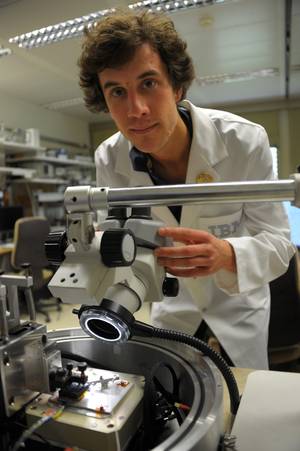World's Smallest Magazine Cover
Interview with
This week researchers in Switzerland have created the smallest magazine cover in  the world, using a tiny chisel to create an image so minute that 2,000 of them could fit on a grain of salt.
the world, using a tiny chisel to create an image so minute that 2,000 of them could fit on a grain of salt.
Colin Rawlings is one of the researchers behind the work...
Chris - The number one question must be, why on Earth have you done this?
Colin - Well, it sort of seemed like a fun thing to do, but also more generally, it was the work done with National Geographic, the guys that supplied the cover and they were looking for a way to sort of show kids that you could do surprising and weird things with science. So, at IBM we were pretty happy to get involved in that.
Chris - IBM has something of a rep for doing things with very small things. I remember iconically the spelling of IBM in xenon atoms about 25, 30 years ago, made lots of magazine covers then. Actually, how did you do this though? How did you actually make these tiny images?
Colin - It's actually related sort of to that work that Don Eigler did, I think that we use a very sharp tip and we start with a flat plastic layer. And then by applying or heating up the tip and then pushing it into the surface, we cause the plastic to evaporate and so we're left them with a sort of a hole in the area that we touched down on. Then if you scan over the surface making holes of the correct depth at each point, what you're left with is a sort of 3D topography of hills and valleys that if you do it correctly, it can look like a magazine cover or indeed, anything else that you want it to resemble.
Chris - So, the magazine cover is a slightly trivial application, but makes the point. Obviously, makes you very news worthy, but the point being that you could use the same technique then to make any kind of 3 dimensional microstructure, very tiny structures that you would need or have some kind of function for.
Colin - Yeah, exactly, that's right. So, as the technique gets more mature, that's sort of the processes, or sort of the way we try and go with this and there are things that you can do with 3D structures that it's hard to do with the sort of 2D structures that you can make with traditional techniques.
Chris - What sorts of things are you going to make?
Colin - So, there's now one effort that if you can focus light to a high enough degree then you can get interesting quantum effects that otherwise wouldn't be possible. So, that's something that - a paper that came out I think a year or two ago showing this theoretically and now, we try and make the experimental validation of this.
Chris - Why is this any better than what we can already do with what's dubbed "photo lithography" where we etch bits of silicon to make microchips which must be on the same sort of scale or smaller than what you are achieving here?
Colin - Yeah, exactly. In mean, the scale that we can do this on is actually a little bit better than you can do with optical lithography. Of course, where we lose its speed that it takes us much longer because we have to do it point by point. But I think the key difference is, firstly, that you can see what you've done straightaway. So, for scientists who are a bit error prone, this is a pretty nice thing that you can save for yourself a lot of time because you can directly see that you've made a mistake and then have another go. The other thing that we can do is this 3D patterning thing. That instead of writing one 2D shape that you can maybe extrude or stretch out the surface by or etch down into the surface, we can really make a 3D profile...
Chris - Can you also do this with more materials than just the traditional ways of etching microchips with silicon?
Colin - No. I think probably in the end, we're still making a shape and then we still use etching to transfer the shape from the plastic into another material or to apply metal to sort of control where metal is deposited or when dopants be controlled. So, in that sense, it works along the same lines.
- Previous Breathing Buildings
- Next Living to 115










Comments
Add a comment